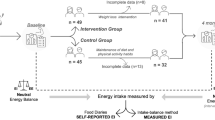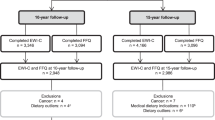Abstract
Background/Objectives:
Research examining associations between eating occasion (EO) frequency and adiposity is inconclusive; studies examining the impact of energy misreporting are rare. This study examined associations between eating patterns and adiposity, with adjustment for energy misreporting, in a nationally representative sample of Australian adults.
Subjects/Methods:
Dietary intake was assessed via two 24-h recalls collected during the 2011–12 National Nutrition and Physical Activity Survey (n=4050 adults, aged ⩾19 years). Frequencies of all EOs, meals and snacks were calculated. Height, weight and waist circumference (WC) were measured. Energy misreporting was assessed as the ratio of energy intake to predicted energy expenditure (EI:EE). Energy misreporters were identified by EI:EE ratios, <0.68 or >1.32. Multivariate regression models assessed associations between eating patterns and body mass index (BMI), WC, overweight/obesity (BMI ⩾25 kg m−2) and central overweight/obesity (WC ⩾94 cm in men and ⩾80 cm in women).
Results:
After adjustment for covariates and EI:EE, frequency of all EOs, meals (women only) and snacks was positively associated with WC and BMI (all P<0.01). Snack, but not meal frequency, was also associated with overweight/obesity (men: OR=1.22, 95% CI 1.07–1.39; women: OR=1.26, 95% CI 1.10–1.43) and central overweight/obesity (men: OR=1.17, 95% CI 1.04–1.32; women: OR=1.21, 95% CI 1.06–1.37). Multivariate analysis that excluded energy misreporters and adjusted for EI yielded either null or inverse associations (P<0.05).
Conclusions:
These findings suggest that the associations between eating patterns and adiposity are complicated by the role of EI and energy misreporting. Longitudinal research that considers the impact of EI and energy misreporting is needed to better understand the relationship between eating patterns and obesity.
This is a preview of subscription content, access via your institution
Access options
Subscribe to this journal
Receive 12 print issues and online access
$259.00 per year
only $21.58 per issue
Buy this article
- Purchase on Springer Link
- Instant access to full article PDF
Prices may be subject to local taxes which are calculated during checkout
Similar content being viewed by others
References
Ma Y, Bertone ER, Stanek EJ 3rd, Reed GW, Hebert JR, Cohen NL et al. Association between eating patterns and obesity in a free-living US adult population. Am J Epidemiol 2003; 158: 85–92.
Wang YQ, Zhang YQ, Zhang F, Zhang YW, Li R, Chen GX . Increased Eating Frequency Is Associated with Lower Obesity Risk, But Higher Energy Intake in Adults: A Meta-Analysis. Int J Environ Res Public Health 2016; 13: pii: E603.
House BT, Shearrer GE, Miller SJ, Pasch KE, Goran MI, Davis JN . Increased eating frequency linked to decreased obesity and improved metabolic outcomes. Int J Obes (Lond) 2015; 39: 136–141.
Zhu Y, Hollis JH . Associations between eating frequency and energy intake, energy density, diet quality and body weight status in adults from the USA. Br J Nutr 2016; 115: 2138–2144.
Holmback I, Ericson U, Gullberg B, Wirfalt E . A high eating frequency is associated with an overall healthy lifestyle in middle-aged men and women and reduced likelihood of general and central obesity in men. Br J Nutr 2010; 104: 1065–1073.
Smith KJ, Blizzard L, McNaughton SA, Gall SL, Dwyer T, Venn AJ . Daily eating frequency and cardiometabolic risk factors in young Australian adults: cross-sectional analyses. Br J Nutr 2012; 108: 1086–1094.
Titan SM, Bingham S, Welch A, Luben R, Oakes S, Day N et al. Frequency of eating and concentrations of serum cholesterol in the Norfolk population of the European prospective investigation into cancer (EPIC-Norfolk): cross sectional study. BMJ 2001; 323: 1286–1288.
Bellisle F, McDevitt R, Prentice AM . Meal frequency and energy balance. Br J Nutr 1997; 77: S57–S70.
Leidy HJ, Campbell WW . The effect of eating frequency on appetite control and food intake: brief synopsis of controlled feeding studies. J Nutr 2011; 141: 154–157.
Chapelot D, Marmonier C, Aubert R, Allegre C, Gausseres N, Fantino M et al. Consequence of omitting or adding a meal in man on body composition, food intake, and metabolism. Obesity (Silver Spring) 2006; 14: 215–227.
Farshchi HR, Taylor MA, Macdonald IA . Beneficial metabolic effects of regular meal frequency on dietary thermogenesis, insulin sensitivity, and fasting lipid profiles in healthy obese women. Am J Clin Nutr 2005; 81: 16–24.
Stote KS, Baer DJ, Spears K, Paul DR, Harris GK, Rumpler WV et al. A controlled trial of reduced meal frequency without caloric restriction in healthy, normal-weight, middle-aged adults. Am J Clin Nutr 2007; 85: 981–988.
Verboeket-van de Venne WPHG, Westerterp KR, Kester ADM . Effect of the pattern of food intake on human energy metabolism. Br J Nutr 1993; 70: 103–115.
Perrigue MM, Drewnowski A, Wang CY, Neuhouser ML . Higher eating frequency does not decrease appetite in healthy adults. J Nutr 2016; 146: 59–64.
Mills JP, Perry CD, Reicks M . Eating frequency is associated with energy intake but not obesity in midlife women. Obesity (Silver Spring) 2011; 19: 552–559.
Summerbell CD, Moody RC, Shanks J, Stock MJ, Geissler C . Relationship between feeding pattern and body mass index in 220 free-living people in four age groups. Eur J Clin Nutr 1996; 50: 513–519.
Kant AK, Schatzkin A, Graubard BI, Ballard-Barbash R . Frequency of eating occasions and weight change in the NHANES I Epidemiologic Follow-up Study. Int J Obes Relat Metab Disord 1995; 19: 468–474.
Edelstein SL, Barrett-Connor EL, Wingard DL, Cohn BA . Increased meal frequency associated with decreased cholesterol concentrations; Rancho Bernardo, CA, 1984-1987. Am J Clin Nutr 1992; 55: 664–669.
Murakami K, Livingstone MB . Eating frequency is positively associated with overweight and central obesity in US adults. J Nutr 2015; 145: 2715–2724.
Murakami K, Livingstone MB . Eating frequency in relation to body mass index and waist circumference in British adults. Int J Obes (Lond) 2014; 38: 1200–1206.
Leech RM, Worsley A, Timperio A, McNaughton SA . Understanding meal patterns: definitions, methodology and impact on nutrient intake and diet quality. Nutr Res Rev 2015; 28: 1–21.
Huang TT, Roberts SB, Howarth NC, McCrory MA . Effect of screening out implausible energy intake reports on relationships between diet and BMI. Obes Res 2005; 13: 1205–1217.
McCrory MA, Howarth NC, Roberts SB, Huang TT . Eating frequency and energy regulation in free-living adults consuming self-selected diets. J Nutr 2011; 141: 148–153.
Subar AF, Kipnis V, Troiano RP, Midthune D, Schoeller DA, Bingham S et al. Using intake biomarkers to evaluate the extent of dietary misreporting in a large sample of adults: the OPEN study. Am J Epidemiol 2003; 158: 1–13.
Berteus Forslund H, Lindroos AK, Sjostrom L, Lissner L . Meal patterns and obesity in Swedish women-a simple instrument describing usual meal types, frequency and temporal distribution. Eur J Clin Nutr 2002; 56: 740–747.
Murakami K, Livingstone MB . Associations between meal and snack frequency and diet quality and adiposity measures in British adults: findings from the National Diet and Nutrition Survey. Public Health Nutr 2015; 19: 1624–1634.
Leech RM, Livingstone KM, Worsley A, Timperio A, McNaughton SA . Meal frequency but not snack frequency is associated with micronutrient intakes and overall diet quality in Australian men and women. J Nutr 2016; 146: 2027–2034.
Murakami K, Livingstone MB . Associations between Meal and Snack Frequency and Diet Quality in US Adults: National Health and Nutrition Examination Survey 2003-2012. J Acad Nutr Diet 2016; 116: 1101–1113.
Australian Bureau of Statistics Australian Health Survey: Users' Guide, 2011-13. Cat. no. 4363.0.55.001. ABS: Canberra, Australia, 2013.
World Health Organization Obesity: preventing and managing the global epidemic. Report of a WHO Consultation (WHO Technical Report Series 894). WHO: Geneva, Switzerland, 2000.
World Health Organization Waist circumference and waist-hip ratio: report of a WHO expert consultation, Geneva, 8-11 December 2008. WHO: Geneva, Switzerland, 2008.
Moshfegh AJ, Rhodes DG, Baer DJ, Murayi T, Clemens JC, Rumpler WV et al. The US Department of Agriculture Automated Multiple-Pass Method reduces bias in the collection of energy intakes. Am J Clin Nutr 2008; 88: 324–332.
Blanton CA, Moshfegh AJ, Baer DJ, Kretsch MJ . The USDA Automated Multiple-Pass Method accurately estimates group total energy and nutrient intake. J Nutr 2006; 136: 2594–2599.
Food Standards Australia New Zealand About AUSNUT 2011-13 2013: FSANZ: Canberra.
Leech RM, Worsley A, Timperio A, McNaughton SA . Characterizing eating patterns: a comparison of eating occasion definitions. Am J Clin Nutr 2015; 102: 1229–1237.
Popkin BM, Duffey KJ . Does hunger and satiety drive eating anymore? Increasing eating occasions and decreasing time between eating occasions in the United States. Am J Clin Nutr 2010; 91: 1342–1347.
Institute of Medicine Dietary reference intakes for energy, carbohydrates, fiber, fat, fatty acids, cholesterol, protein and amino acids. National Academy Press: Washington, DC, USA, 2002.
Murakami K, Livingstone MB . Prevalence and characteristics of misreporting of energy intake in US adults: NHANES 2003-2012. Br J Nutr 2015; 114: 1294–1303.
McCrory MA, McCrory MA, Hajduk CL, Roberts SB . Procedures for screening out inaccurate reports of dietary energy intake. Public Health Nutr 2002; 5: 873–882.
Pan A, Schernhammer ES, Sun Q, Hu FB . Rotating night shift work and risk of type 2 diabetes: two prospective cohort studies in women. PLoS Med 2011; 8: e1001141.
Australian Institute of Health and Welfare The Active Australia Survey: a Guide and Manual for Implementation, Analysis and Reporting. Cat. no. CVD 22. AIHW: Canberra, Australia, 2003.
The Department of Health Australia's Physical Activity and Sedentary Behaviour Guidelines. DoH: Canberra, Australia, 2014.
McNaughton SA, Ball K, Crawford D, Mishra GD . An index of diet and eating patterns is a valid measure of diet quality in an Australian population. J Nutr 2008; 138: 86–93.
Livingstone KM, McNaughton SA . Diet quality is associated with obesity and hypertension in Australian adults: a cross sectional study. BMC Public Health 2016; 16: 1037.
Thorpe MG, Milte CM, Crawford D, McNaughton SA . A revised australian dietary guideline index and its association with key sociodemographic factors, health behaviors and body mass index in peri-retirement aged adults. Nutrients 2016; 8: 160.
Howarth NC, Huang TT, Roberts SB, Lin BH, McCrory MA . Eating patterns and dietary composition in relation to BMI in younger and older adults. Int J Obes (Lond) 2007; 31: 675–684.
Palmer MA, Capra S, Baines SK . Association between eating frequency, weight, and health. Nutr Rev 2009; 67: 379–390.
Ruidavets JB, Bongard V, Bataille V, Gourdy P, Ferrieres J . Eating frequency and body fatness in middle-aged men. Int J Obes Relat Metab Disord 2002; 26: 1476–1483.
Mendez MA, Popkin BM, Buckland G, Schroder H, Amiano P, Barricarte A et al. Alternative methods of accounting for underreporting and overreporting when measuring dietary intake-obesity relations. Am J Epidemiol 2011; 173: 448–458.
Vainik U, Konstabel K, Latt E, Maestu J, Purge P, Jurimae J . Diet misreporting can be corrected: confirmation of the association between energy intake and fat-free mass in adolescents. Br J Nutr 2016; 116: 1425–1436.
Acknowledgements
This research was supported by a National Heart Foundation of Australia Future Leader Fellowship (Award 100046 to AT) and by a National Health and Medical Research Council Career Development Fellowship (ID1104636 to SAM). AT is supported by a National Heart Foundation of Australia Future Leader Fellowship (Award 100046). SAM is supported by a National Health and Medical Research Council Career Development Fellowship (ID1104636).
Author information
Authors and Affiliations
Corresponding author
Ethics declarations
Competing interests
The authors declare no conflict of interest.
Rights and permissions
About this article
Cite this article
Leech, R., Worsley, A., Timperio, A. et al. The role of energy intake and energy misreporting in the associations between eating patterns and adiposity. Eur J Clin Nutr 72, 142–147 (2018). https://doi.org/10.1038/ejcn.2017.90
Received:
Revised:
Accepted:
Published:
Issue Date:
DOI: https://doi.org/10.1038/ejcn.2017.90
This article is cited by
-
Characterizing children’s eating patterns: does the choice of eating occasion definition matter?
International Journal of Behavioral Nutrition and Physical Activity (2021)
-
Eating patterns of Australian adults: associations with blood pressure and hypertension prevalence
European Journal of Nutrition (2019)



